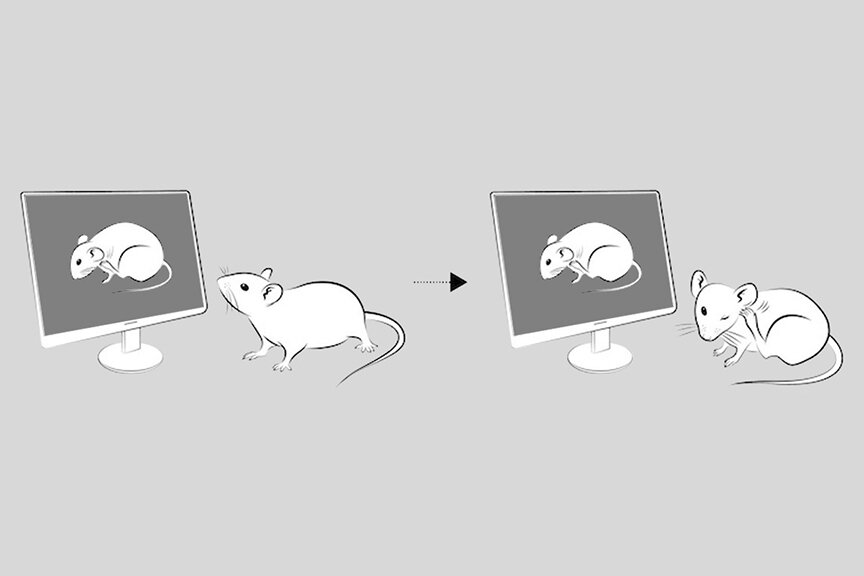Researchers at Washington University School of Medicine in St. Louis have identified a pathway in the mouse brain independent of the visual cortex that is activated when the animals see other mice scratching. Credit: Chen Lab/Washington University School of Medicine
Researchers at the Washington University School of Medicine in St. Louis have identified a pathway in the brains of mice that is activated when the animals see other mice scratching. Researchers have previously reported that the urge to scratch an itch after seeing other mice scratch is hardwired into the brain. Now they have discovered that this so-called “contagious itch” is controlled by a visual pathway that, surprisingly, works independently of the visual cortex, the area of the brain that processes visual information.
The new findings contribute to understanding the triggers that cause itchiness and may eventually point to solutions to stop itchiness-related diseases in humans. The work also provides additional evidence that some cells in the retina not previously associated with sight can help us as we see.
The new study was published on October 4 in the journal Cell reports.
“This contagious itching, which is a reflex response in mice, like grooming, must be somehow important for survival,” said lead researcher Zhou-Feng Chen, Ph.D., director of the Center for the Study of Itch at the University of Washington. and sensory disturbances. “We humans also experience contagious itch, but we found that in mice this itch is controlled by a pathway that is not known to be responsible for ‘seeing’ things. This may mean that similar imitative grooming behavior is an ancient, protective behavior.”
Using techniques to disable the visual cortex, the researchers found that even a mouse without a functioning visual cortex will scratch when faced with another doing the same.
In a series of detailed experiments, Chen’s team found that responding to other mice scratching requires a recruitment of specialized cells in the mouse retina. These cells are known as intrinsically photosensitive retinal ganglion cells (ipRGC), connect to suprachiasmatic nucleus, a tiny region of the brain that is responsible for controlling the circadian rhythm, causing activation of the scratching cascade. In 2017, the same research group found that the suprachiasmatic nucleus was highly active when mice started scratching after watching videos of other mice scratching.
“If you delete a specific neuropeptide that transmits signals from the ipRGC, mice don’t scratch, whether the visual cortex is intact or not,” he explained. “Mice without a functional visual cortex are able to detect this scratching movement, and so they scratch. It’s a behavior that seems essential to their survival.”
He compares this phenomenon to when a frog catches an insect for food. Frogs do not have a visual cortex, but their eyes are very sensitive to movement. They can tell when an insect is flying in a certain direction or in a certain direction and can then stick their tongue out to catch and eat it. Chen believes that something similar happens with the contagious itch response in mice.
“We found that ipRGCs and some cells in the brain’s suprachiasmatic nucleus are very sensitive to scratching movements of the mouse,” he said. “We humans also feel itchy when we see other people scratching, and we tend to yawn when we see other people yawning, but it’s not clear whether this reflex has any benefit to us. In humans, the route of pruritus transmission may be different from what we saw in mice. Human response is likely to require optic tubercle. But in humans, contagious itching may simply be a holdover from evolution. You have to go back to animals like these mice to find out why these types of behaviors were once or might still be important for survival.”
Perhaps, he said, because mice are nocturnal and often in dark places, it might be important for them to know if the area they’re moving to might be full of insects like mosquitoes. Because of their poor eyesight, one way for mice to learn this is to see what other mice are doing. If mice start scratching nearby, this can be a warning signal that mosquitoes or other insects are biting.
“You better scratch your head before the mosquitoes bite you too,” he said. “This kind of contagious behavior is widespread in the animal world.”
To learn more about how visual pathway that was discovered during these experiments may be important for survival, Chen’s team is now studying how mice without functioning, the visual cortex responds to other kinds of stimuli.
Fang Gao et al., A non-canonical visual retina-ipRGCs-SCN-PVT pathway to mediate infectious itch, Cell reports (2022). DOI: 10.1016/j.celrep.2022.111444. www.cell.com/cell-reports/full … 2211-1247(22)01285-2
Citation: Scientists identify pathway that makes mice scratch when they see others do the same (2022, October 4) retrieved October 4, 2022 from https://medicalxpress.com/news/2022-10-scientists -pathway-triggers-mice.html
This document is subject to copyright. Except in good faith for the purpose of private study or research, no part may be reproduced without written permission. The content is provided for informational purposes only.







